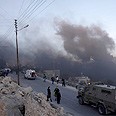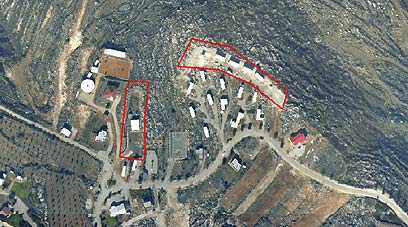
Peace Now: Settlements expanded faster in 2008
On day US Mideast envoy arrives in Israel, Peace Now movement publishes report on settlement expansion activity last year. Yesha Council pleased with 'documentation of Zionist enterprise'
Jewish settlements and outposts in the West Bank expanded more rapidly in 2008 than the previous year, Peace now reported on Wednesday. The timing of the report is no coincidence, and it was released on the day US Envoy to the Middle East George Mitchell was scheduled to arrive in Israel.
Mitchell has spoken out against the illegal construction of settlements in the occupied Palestinian territories in the past.
According to the report, there were 285,800 settlers living in the West Bank as of 2008, with 1,518 new structures built in the territories last year, including 261 outposts.
Sixty-one percent of the new structures were built west of the route of the separation fence and 39% were built east of it. A quarter of the new structures east of the fence were built in outposts.
At least 1,257 new structures were built in existing settlements, including 748 permanent buildings and 509 caravans compared to 800 structures in 2007 - a 60% rise. In addition the ground was prepared for the construction of 63 new structures.

Differences in Itamar settlement between May-December 2008
Peace Now also presented a list of settlements with large construction project in the last six months: Alfei Menashe (16 new structures), Efrat (15 new structures), Beit Arye (27 new structures), Beitar Illit (18 new structures), Keidar (13 new structures), Giv'at Ze'ev (10 new structures), Modi'in Illit (35 new structures), Ma'ale Adumim (13 new structures), Ma'ale Shomron (19 new structures).
Settlements in which at least 10 new caravans were built in the last half-year are Har Bracha, Ofra, Kiryat Arba and Shilo.
Outposts
The report continued to say that not a single real outpost was evacuated in 2008, and at least 261 new structures were built, including 227 caravans and 34 permanent structures, compared to 98 structures in 2007 (including 82 caravans and 16 permanent structures).
In addition the ground was prepared for the construction of nine new permanent structures.In three of every four outposts construction or development work took place in 2008.
Besides these outposts there is a large number of additional points controlled by the settlers but without their permanent presence.
At the outpost of Migron for example the settlers added 5 new structures and began building an extension for another permanent structure.
The Peace Now report said, "It seems that the government announcement to the High Court of Justice that it agreed with the settlers to evacuate Migron and relocate it to the settlement of Adam must have encouraged the settlers to begin construction at Migron, because if the relocation does take place it will take years."
'Settlers took advantage of Gaza war'
During the war in Gaza the settlers took advantage of the fact that all public attention was on the south to expand construction in the outposts and settlements, the report said.
The organization said at this point it is difficult to assess the amount of construction done during the weeks of the war but it can be stated with certainty that a number of new roads were opened, with the goal of extending control in the areas near the settlements.
Roads opened include one connecting the settlement of Eli with the settlement of Shilo, a road extending control surrounding the outpost of Haro'e and an expanded road ascending from Eli cemetery towards Hayovel outpost.
The report continued to say that in 2008 tenders were issued to build 539 new housing units in the settlements, compared to only 65 housing units in 2007, an eight-fold increase in the number of tenders.

New structure built in Givat Harel from May - December 2008
Construction permits were also granted for the beginning of work on large projects west of the fence: Nine-hundred-and-fifty housing units in Ma'ale Adumim, 800 housing units in Giv'at Ze'ev, 100 housing units in Ariel and more.
In addition a considerable momentum began in planning and construction in east Jerusalem.
Peace Now said Defense Minister Ehud Barak approved dozens of construction plans in settlements in 2008, some east of the fence.
Among the substantial plans approved was the establishment of the settlement of Sansana -in southern Mount Hebron, establishment of the settlement of Maskiyot, the expansion of the settlement in Hebron, and more.
According to the report all the outposts Barak declared were evacuated were not fully evacuated. The evacuation of the disputed house in Hebron is the exception.
Peace Now Secretary-General Yariv Oppenheimer said, "The Labor-Kadima government is a big disappointment in anything to do with freezing construction in settlements.
The settlers don't have to wait for Bibi (Netanyahu), since the present government has allowed construction not just in settlement blocks, but also in isolated settlements and outposts."
'Most important Zionist enterprise of our time'
Yesha Council said in response, "Once again we thank Peace Now for allocating the money they get from the European Union towards documenting the most important Zionist enterprise of our generation – settling in Judea and Samaria."The Council added that "some of the data are not exactly accurate. The number of settlers today according to official data stands at over 300,000 Israelis.
"Regarding the allegations of 'taking advantage' of the war to pave roads, all of Israel knows who took advantage of the war to demonstrate against IDF soldiers and who sent their sons to the front line to give their soul in defense of the State."
Meanwhile, the Yesha Council plans to welcome American Envoy George Mitchell.
On Wednesday, settlers will put on a special presentation titled "A Palestinian state will blow up in our face", in an attempt to illustrate the "dangers establishing a Palestinian state in Judea and Samara would pose on central Israel, following the lessons learned from the disengagement, the rockets on Beersheba, Gedera and the war in the south".
The three-dimensional presentation will be accompanied by audio and visual effects and will travel on a large truck from Tel Aviv to Jerusalem during Mitchell's meetings with the heads of the State.










